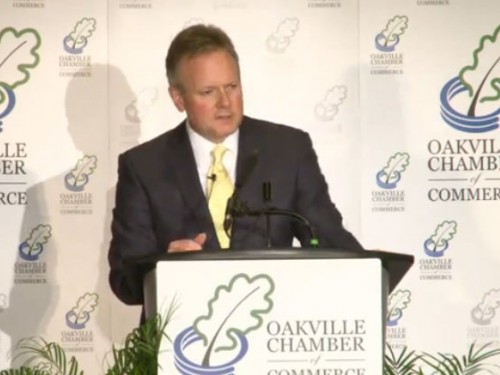Reconstruction: Rebuilding Business Confidence in Canada
Introduction
Thank you for that introduction and to all of you for coming today. It is a pleasure to deliver my first public speech as Governor of the Bank of Canada here in the heart of southern Ontario, especially since we are just down the road from my hometown of Oshawa.
This region is a historic centre of Canadian industry and commerce. It is home to some of Canada’s most storied businesses and prestigious centres of learning. Many of the firms that made this region and Canada strong were on the front lines as the global financial crisis pushed the Canadian economy into recession. As our economy continues to expand, it will be the performance of the business sector here and across Canada over the coming while that we will be watching with great interest.
That’s because what happens to business in Canada matters for the Bank of Canada. Not just because we care - which, let me assure you, we do. But in order for us to do our job properly, in order for us to promote the economic and financial welfare of Canadians, we need to understand all the dynamics that feed into the Canadian economy.
The Bank aims to keep inflation low, stable and predictable. Our flexible inflation-targeting framework is the best contribution monetary policy can make so that Canadian households and businesses can make decisions about their financial futures with confidence.
Over the past couple of decades, the average rate of inflation has been very close to our 2 per cent target. Even during the global economic and financial crisis, our commitment did not waver. The inflation target is sacrosanct to us and has become a credible anchor for the inflation expectations of Canadians.
Moreover, the target is symmetrical: we care just as much about inflation falling below as we do about it rising above the target. When inflation falls below the target and interest rates are correspondingly low, there is little room for conventional monetary policy to respond to negative shocks. When inflation is above target, the erosion of purchasing power becomes significant and uncertainty about future prices makes it hard for households and businesses to make good financial decisions.
Further, the framework has built-in flexibility with respect to the amount of time it takes to return inflation to target after a shock. Years of successful inflation targeting have given the Bank the credibility to use this flexibility during periods of economic stress. A flexible exchange rate is also key to achieving our inflation targets over time.
The recent turmoil showed us the value of the credibility we have earned. Like others, to address the stresses of the crisis, we put the flexibility of our regime to work. Nonetheless, throughout the recession and since, the inflation expectations of Canadians have remained well anchored at the target, proving that our framework is secure and working.
This past downturn was different from previous recessions. Even though Canada performed better than our G-7 peers, the Great Recession put many companies out of business, especially small and exporting firms. Many of those that survived dramatically reduced their operations, shuttering plants and dismantling equipment.
These actions hurt - badly - in terms of job losses and lost output. While both have recovered - in fact, surpassed their pre-recession peaks - the structural damage caused by the crisis lingers. Indeed, our recovery has been primarily driven by higher household spending, while exports have lagged behind.
Rather than a recovery in the usual sense, this looks more like a postwar reconstruction. Or, if you will allow me to slide into more academic language for a moment and refer to the Schumpeterian process of “creative destruction,” we’ve certainly had the destruction. But the creation side of the equation has been delayed by numerous unusual risks, heightened uncertainty, and a lack of confidence.
This is what I want to talk about today. I want to discuss the impact of the crisis on Canadian business and how the firms that have survived have changed and are responding. We need business confidence to continue to heal. This matters very much to the Bank of Canada.
Our understanding of these issues will be part of the rigorous distillation of information that drives our policy decisions. As part of the process, we meet, we talk, we argue and do our best to understand the significant forces driving the economy. With our next policy decision on 17 July, we are now at the early stage of this round.
Standard macroeconomic models can only go so far in capturing today’s dynamics, and especially when uncertainty is greater than normal, it is important to supplement the models with insights directly from business.
My messages today will be relevant for companies across Canada, but they resonate particularly in this region. As a native of Oshawa, I understand that well. I have seen the impact of the crisis and the recession on the auto sector in my hometown. I have heard about it from the manufacturers and exporters in this region. And the Bank has heard about it from the financial community on Bay Street and from all types of business leaders in southern Ontario who participate in the Bank’s quarterly business outlook surveys.
Worst Recession Since the Depression
I probably don’t need to tell anyone in this room that the recent global recession was the worst downturn experienced since the Great Depression. In very short order, global GDP fell more than 3 per cent and millions upon millions of jobs were lost. In Canada, 432,000 jobs were lost and GDP fell 4.2 per cent. The unemployment rate spiked to 8.7 per cent.
The severity of the global economic and financial crisis delivered a direct, sharp blow to Canadian business. Canada experienced a particularly deep contraction of investment and exports.
The trauma was severe and long-lasting. Its impact was felt by businesses across the country, businesses that saw their markets dwindle and their balance sheets deteriorate. In a downturn that lasts, say, nine months, a bank will likely let its clients ride out the recession. But in a prolonged crisis, the story is more complex. Credit can become tough to find. Anecdotally, we know that otherwise solvent and creditworthy firms were left with considerably less credit than they needed. In too many cases, temporary plant shutdowns were not sufficient to match the fall in demand or the decline in financing. Some firms reduced their operations. Others simply closed their doors.
Let’s look at some of the facts. During a normal growth period in Canada, there is a steady increase in the number of businesses in operation. In short, creative destruction results in the net creation of new firms. But since the onset of the recession, there has been limited net creation of businesses. Canada’s exporters have been particularly hard hit. The group most profoundly affected has been manufacturing exporters, whose ranks have continued to shrink.
Canada is not alone in this regard. In the United States, the dynamics were similar but even more dramatic. The net number of new establishments fell for three years in a row until 2011, when, finally, the trend turned around.
The Reconstruction Challenge
Perhaps there should be no surprise, then, given the decline in global demand, the drop in the number of American companies to trade with, and the related drop in the number of Canadian exporters, that Canada’s export sector has lagged. It is the only component of Canada’s GDP that remains below its pre-recession peak. Our annual exports are more than $100 billion lower than would be typical at this point in a recovery cycle.
Regaining the lost output of companies that have disappeared or downsized will require that existing firms boost their production, that they invest to expand their capacity, and that the net creation of new firms resumes a higher growth path. The good news is that the balance sheets of corporate Canada are healthy and the capacity to invest exists.
We could see that the recession was causing a significant structural change in the Canadian economy at the time. The Bank acknowledged that this destruction of potential was happening in its quarterly Monetary Policy Report in April 2009. Reflecting its best judgment, the Bank reduced its estimates of potential output growth in each of the years from 2009 to 2011.
Nonetheless, we were relatively fortunate in Canada. In the immediate aftermath of the crisis, stimulative monetary and fiscal policies proved highly effective in maintaining domestic demand, particularly household expenditures. Household spending was supported by strong growth in borrowing, which resulted in record-high debt-to-income levels.
Given the circumstances, it was a good thing that households had the capacity to expand their spending - this provided a necessary cushion from the worst effects of the global contraction. The Bank has been careful to remind people that interest rates will rise at some point. We have urged homeowners and other borrowers to do the arithmetic to ensure that they will be able to manage their debts at more normal interest rates. I am confident that this is exactly what people are doing.
This growth model has been effective, but its limits are clear. In fact, while recent data are choppy, we continue to see a constructive evolution of activity in the housing sector. What needs to happen next is for export momentum to build and business investment to recover while the household sector settles into a more balanced and sustainable growth path.
For all of this to happen will require the rebuilding of Canada’s economic potential. That is what makes this recovery cycle unique.
Automotive sector
Let me use some cases studies to illustrate this. The structural transformation of the auto sector has been dramatic. The 70-per cent decline in production from peak to trough was brutal. Machinery was boxed up and sent overseas. Plants closed. These were very hard times for this sector and those who make their living from it.
The crisis in the auto sector prompted the federal government to step in with extraordinary financial support. That support helped save thousands of jobs throughout southern Ontario.
The firms that survived have lowered their cost structures. We are seeing more innovative processes and accelerated new product development. These elements improve the competitiveness of Canadian firms and position them well to go head-to-head with U.S. and global parts-sector firms. They also help Canada to gain a foothold in global supply chains.
The recovery of auto sales in the United States is clearly under way - the first essential ingredient. But it remains to be seen how the reconstruction process I’ve discussed today will play out for this important sector.
Forestry
I could tell a similar story about Canada’s forestry sector, which - like the auto sector - is much smaller than before. In 2012, the Canadian forestry industry accounted for about 1.2 per cent of total GDP, down from around 1.6 per cent in 2007. During the same period, almost 60,000 workers - about 20 per cent of the forestry workforce - were displaced. Here, too, the recovery in U.S. housing and the building of new relationships in fast-growing markets, such as China, are contributing to improved confidence.
I could describe similar stories for other sectors including ICT (information and communications technology) and biotechnology. These are all stories that we need to keep watching.
What businesses are telling us
From the frequent conversations the Bank has with business leaders, we know that the entrepreneurial spirit is alive and well in Canada. Some of the decline in exports reflects the ingenuity of Canadian firms, including firms in this region, in responding to the U.S. slowdown by pivoting their products and marketing to the faster-growing segments of the Canadian economy. Others became more competitive through restructuring or finding a niche adjacent to their traditional market.
Such insights feed importantly into the Bank’s understanding of the workings of the Canadian economy, and thus into the policy deliberations of the Bank - and I strongly believe that, especially in these unusual times, as we work to understand the undercurrents of the recovery, this kind of dialogue with the private sector is critical.
Confidence
To realize the economic growth that Canada is looking for - a return to self-sustaining, self-generating growth - we need to see the rebuilding of capacity, through both the expansion of existing companies and the creation of new ones. This will require growing confidence among existing businesses and entrepreneurs.
The gathering momentum in foreign demand, especially in the United States, should help lift the confidence of Canada’s exporters. This is critical for Canadian firms to boost their investment to expand their productive capacity. The sequence we can anticipate is the following: foreign demand will build; our exports will strengthen further; confidence will improve; existing companies will expand; companies will invest to increase capacity; and new ones will be created.
This sequence may already be underway.
Conclusion
To conclude: In monetary policy, actions are critically important. The Bank is absolutely committed, as I mentioned earlier, to keeping inflation predictable, stable and on target so firms can make longer-term decisions in an environment of confidence. But words, too, matter a great deal. By explaining the cross-currents at work in our economy, our projections for what’s ahead, and our monetary policy response, we can help to heal business confidence. And in order to expand our understanding of what’s happening in the real economy, we listen to businesses, to labour groups and to industry associations.
Beneath our economic and financial statistics and analysis are real people, making real decisions. Those decisions are hard to make at any time, but when uncertainty is high and confidence low, they can be even more difficult.
I am optimistic that the signs are there that the process is under way. Right now, what we need most is stability and patience.
To help nurture confidence, an active engagement with Canadians must remain a cornerstone of the policy of the Bank of Canada. So thank you for being here today. I’m keen to hear your views, and I would be pleased to take your questions.


